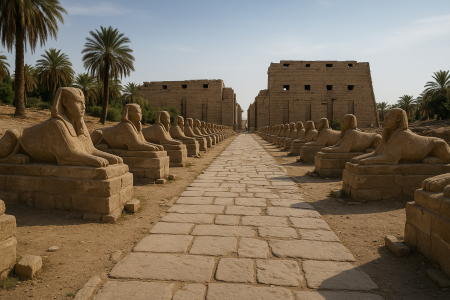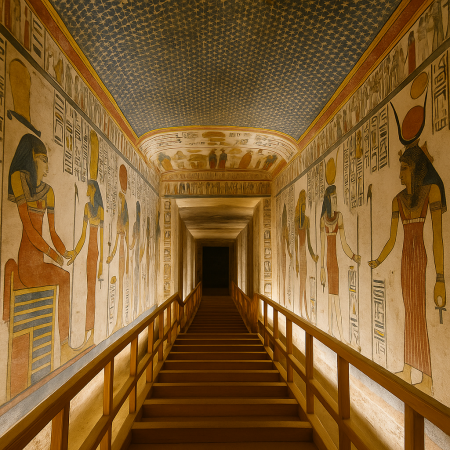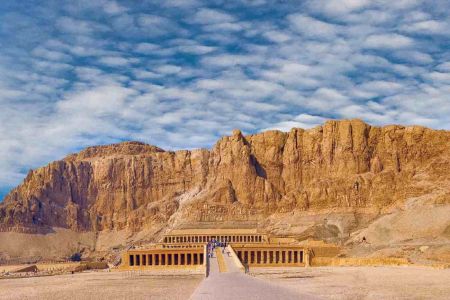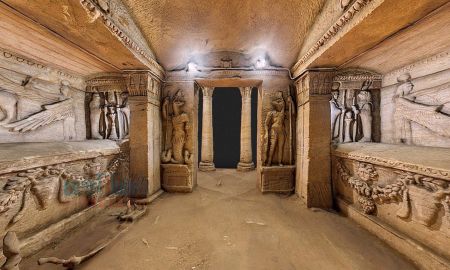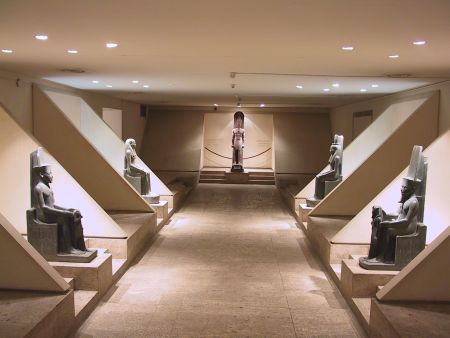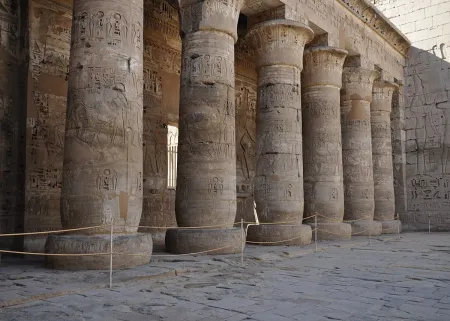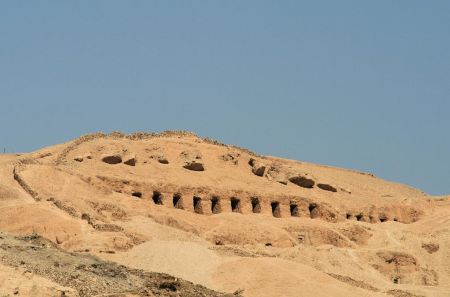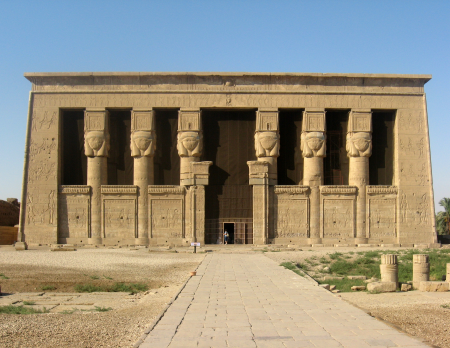Temple of Hatshepsut
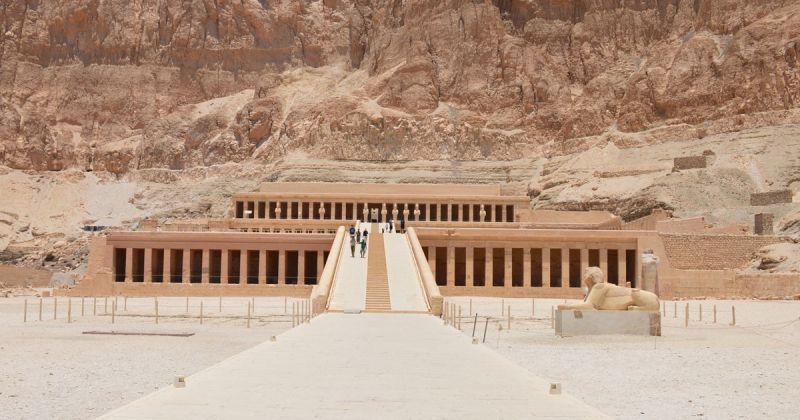
Carved into the cliffs of Deir el-Bahari, the Temple of Hatshepsut rises in stunning harmony with the Theban mountainside—majestic, serene, and revolutionary. This terraced temple, built over 3,400 years ago on the west bank of the Nile near Luxor, honors Hatshepsut, Egypt’s most powerful and successful female pharaoh. It stands not only as a religious complex dedicated to Amun-Ra but as a bold statement of legitimacy, authority, and innovation.
Designed by her architect and steward Senemut, the Mortuary Temple of Hatshepsut blends natural landscape with monumental architecture in a way that was unprecedented at the time. This wasn’t merely a tomb or a place of worship; it was a political and spiritual narrative in stone. With elegant colonnades, divine birth scenes, and exotic trade expeditions carved into its limestone walls, the temple presents Hatshepsut not as a queen, but as a fully divine ruler of Egypt.
What sets this site apart is its poetic symmetry, unmatched grace, and the remarkable story of a woman who defied traditional gender roles to ascend Egypt’s throne. Whether you're a history buff, architecture enthusiast, or spiritual seeker, the Temple of Hatshepsut is a monument that leaves a lasting imprint on the soul.
Historical Background of the Temple of Hatshepsut
Hatshepsut’s Rise to Power: Egypt’s Queen Becomes King
Hatshepsut initially served as regent for her stepson Thutmose III, but within a few years, she declared herself Pharaoh of Egypt—adopting full royal titles, male regalia, and divine status. Her reign (circa 1479–1458 BCE) marked an era of peace, prosperity, and grand architectural achievements. The construction of her mortuary temple at Deir el-Bahari was a crucial part of her strategy to validate her rule and connect herself directly with the gods.
A Temple with Political Purpose
This wasn’t just a mortuary temple for rituals after death. It was a living space for political propaganda and divine legitimation. Reliefs show her divine birth, portraying Amun-Ra as her father, legitimizing her rule through sacred lineage. By aligning herself with male pharaohs and powerful deities, she carved her place into the history books—literally and figuratively.
Architectural Features and Design
Terraced Perfection in Three Levels
The Temple of Hatshepsut features three terraced levels rising gradually toward the cliff face. Connected by wide ramps and framed by colonnades, the layout evokes an architectural rhythm that blends monumentality with aesthetic grace. It mimics the neighboring Temple of Mentuhotep II, yet surpasses it in refinement and complexity.
-
First Terrace: Served as an entry platform, flanked by sphinx-lined avenues and gardens (now lost to time).
-
Second Terrace: Features open courtyards and reliefs of the Punt expedition, showcasing trade, diplomacy, and wealth.
-
Third Terrace: Home to the Sanctuary of Amun-Ra, the spiritual core of the temple, once adorned with golden statues and offerings.
Scenes from the Divine Birth and Punt Expedition
Inside, the reliefs tell stories—political ones. One of the most significant is the Divine Birth Scene, where Amun-Ra impregnates Hatshepsut’s mother, symbolizing the pharaoh’s divine right to rule. Another iconic set of reliefs portrays Hatshepsut’s legendary expedition to the Land of Punt, a mysterious kingdom believed to be in the Horn of Africa. The detailed carvings of incense trees, exotic animals, and foreign tribute emphasize Egypt’s economic and spiritual prosperity under her reign.
Sanctuary and Solar Cult Chapel
At the rear of the third terrace is the Sanctuary of Amun, cut directly into the rock. This dark, holy chamber was where daily rituals and offerings to the sun god took place. It aligns with the winter solstice sunrise, which lights up the sanctuary in an awe-inspiring display—merging architecture, astronomy, and spirituality.
Discover exclusivity and comfort on our Egypt Private Tours
Destruction and Restoration
The Erasure of a Female Pharaoh
After Hatshepsut’s death, her name and image were systematically defaced by Thutmose III and later pharaohs who aimed to reassert male dominance. Her statues were smashed, her cartouches removed, and her legacy nearly erased from official records. Yet her temple endured, and modern archaeology has resurrected her story, restoring her place among Egypt’s greatest rulers.
Modern Restoration Efforts
Since the early 20th century, the Polish-Egyptian Archaeological Mission and other conservation teams have worked meticulously to restore the temple. Today, it stands as one of the most fully reconstructed monuments in Egypt—welcoming thousands of visitors annually and revealing new secrets with every excavation.
Visiting the Temple of Hatshepsut Today
How to Get There
Located in Deir el-Bahari, just across the Nile from Luxor’s east bank, the temple is accessible via car, taxi, or organized tours. Many visitors combine it with trips to the Valley of the Kings, Medinet Habu, and Colossi of Memnon—all within a short distance.
Best Time to Visit
Early mornings (between 6:00–8:00 AM) are ideal to avoid intense heat and crowds. Visiting in the cooler months between October and April provides the most comfortable experience.
Highlights You Shouldn’t Miss
-
The Punt Expedition Reliefs with images of Queen Ati and incense trees.
-
The Divine Birth Scene—a masterclass in royal propaganda.
-
The statues of Osirified Hatshepsut standing as the god of the afterlife.
-
The solar alignment in the Sanctuary of Amun-Ra during the winter solstice.
Frequently Asked Questions About the Temple of Hatshepsut
Why is the Temple of Hatshepsut important?
It represents the political genius, architectural innovation, and spiritual legacy of Egypt’s most successful female pharaoh.
Who designed the Temple of Hatshepsut?
Senemut, Hatshepsut’s chief architect and close advisor, designed the temple to mirror and rival the adjacent Temple of Mentuhotep II.
What was the purpose of the Punt Expedition?
To establish trade routes and acquire luxury goods like myrrh, incense, gold, and exotic animals, enhancing Egypt’s wealth and religious offerings.
Can you visit the Temple of Hatshepsut today?
Yes, it’s open to the public and one of the most visited archaeological sites in Egypt, often included in West Bank tours from Luxor.
Why was Hatshepsut’s name removed from the temple?
Her successor, Thutmose III, aimed to erase her from history to reinforce traditional male kingship, leading to the defacement of her images and inscriptions.
Conclusion: The Legacy of Hatshepsut Etched in Stone
The Temple of Hatshepsut is more than an architectural wonder—it’s a defiant monument to a woman who dared to rule a man’s world. Its elegant terraces, powerful reliefs, and sacred geometry offer not just visual splendor, but insight into the spirit of a leader who transformed Egypt’s destiny. Despite attempts to erase her, Hatshepsut's legacy lives on—in every column, carving, and stone that still stands proudly against the cliffs of Deir el-Bahari. For anyone seeking to understand ancient Egypt’s heart and soul, this temple is not to be missed.


